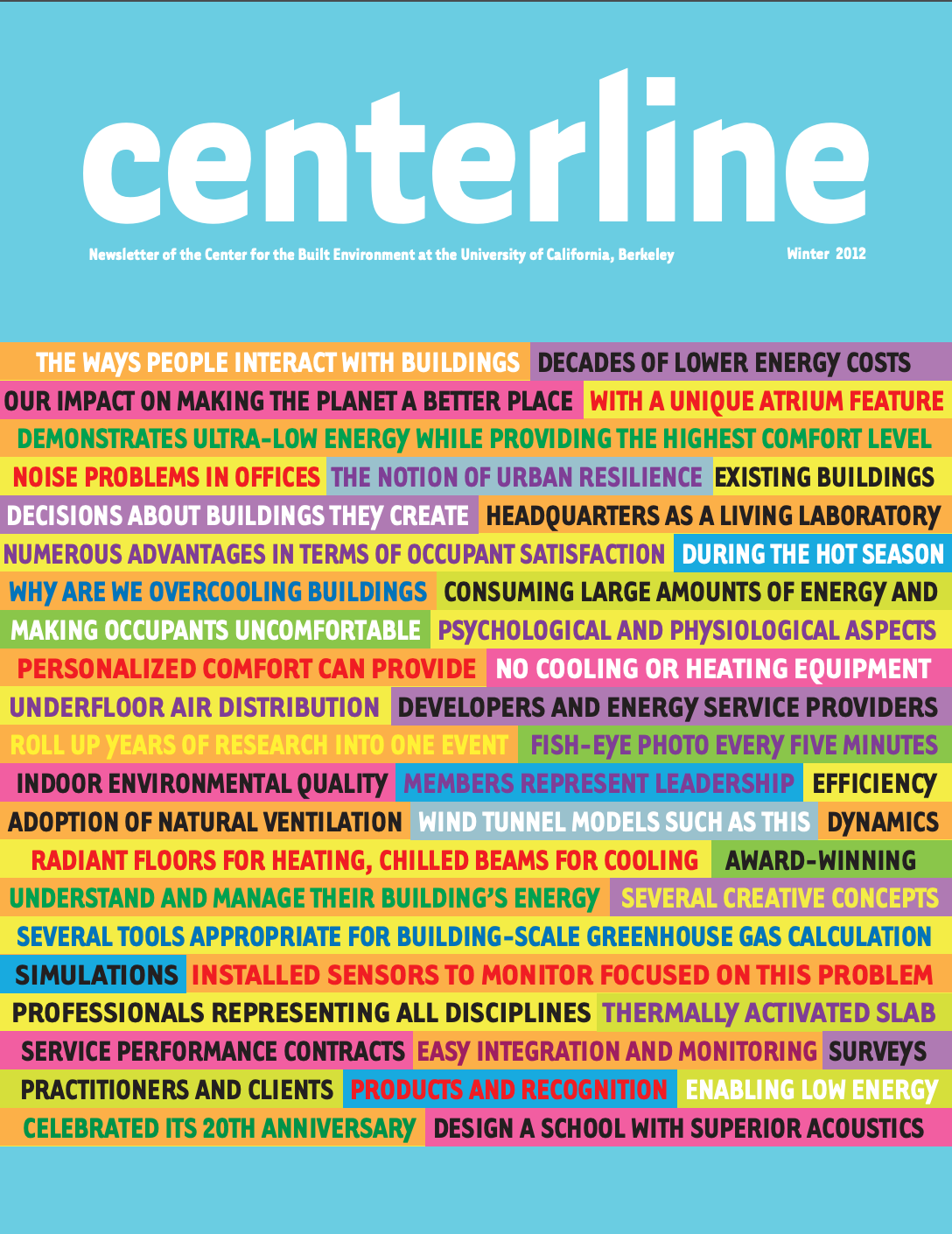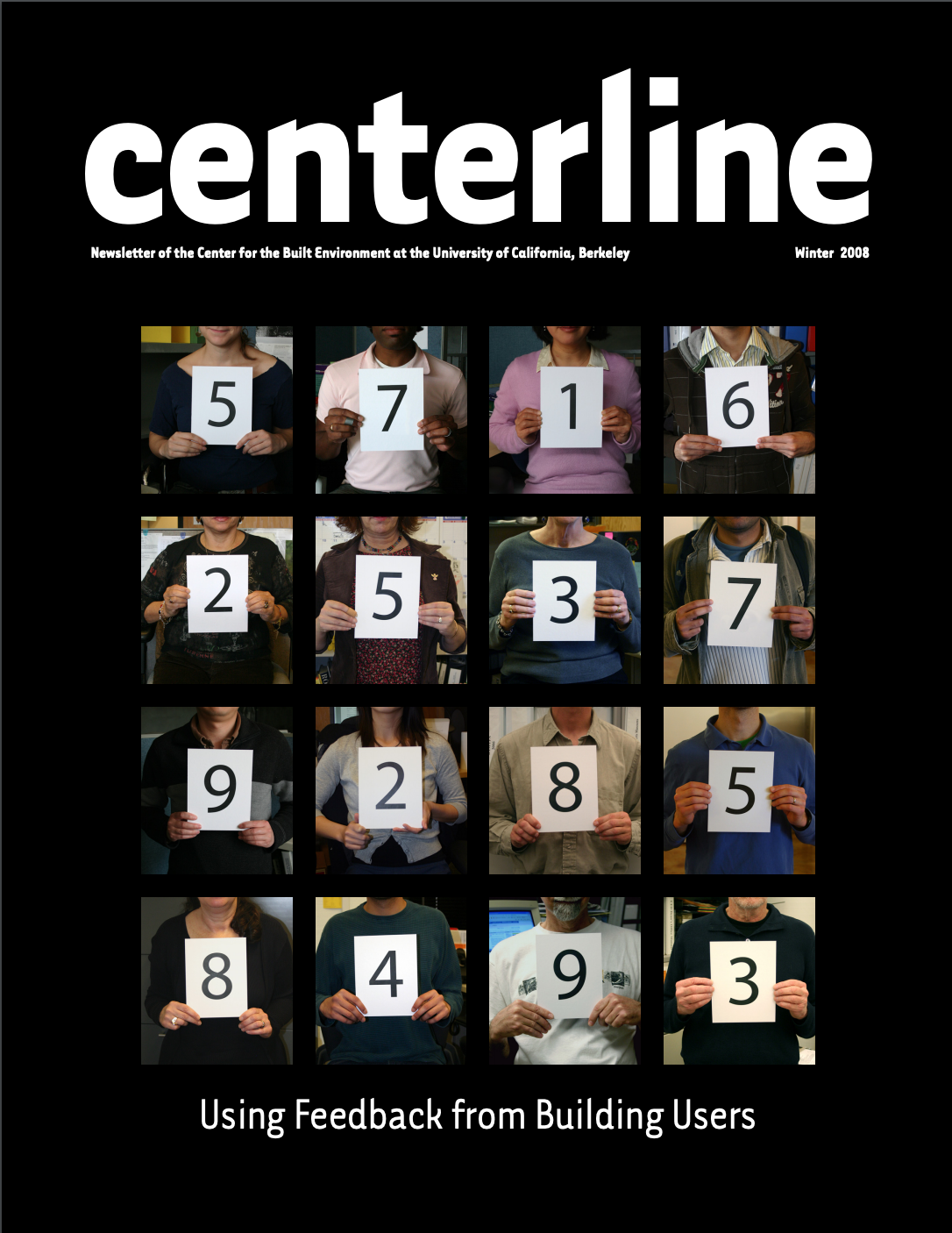
Featured article
Thermostat Wars: Recent media on comfort conflicts in the workplace (pg. 3)
A string of articles and broadcasts in the mainstream media focused on comfort in the workplace, in many cases engaging with faculty and researchers at CBE to provide expert insights. While the idea of building industry sexism may provide a hook for readers, some of this coverage exaggerates the influence of gender on workplace comfort.

Featured article
Doing Well and Doing Good: Pro Bono Design and Community Support (pg. 3)
Themes of social inequality are prevalent in today’s media, from the growing gap between the wealthy and the middle class, to the fatal shootings by police of unarmed men and children that set off angry protests across the U.S. While such challenges are daunting, architects and engineers are problem solvers by nature, and many are applying their professional expertise to assist disadvantaged groups in their communities.

Featured article
The Internet of Things in Commercial Buildings (pg. 3)
The mainstream and technology media are currently flooded with hopeful predictions surrounding the Internet of Things (IoT), a synthesis of technologies that are beginning to connect and bring intelligence to millions of diverse devices and objects, expanding our ability to monitor, understand, and control the world around us. Will IoT in buildings truly have a disruptive impact on commercial buildings?

Featured article
Personal Comfort Innovations (pg. 6)
In earlier issues of Centerline, we described how a new office chair prototype developed at CBE will give people improved control over their workplace environment – and at the same time save HVAC energy. Over the past few months we have made great strides towards publicizing and commercializing this innovative chair concept, and adding features that will enable integration with building control systems.

Featured article
High Tech Meets High Touch: Controlling Buildings Using Occupant Feedback (pg. 3)
Controlling a building based on generalized occupant preferences – not complaints – is a revolutionary approach. CBE will launch new interdisciplinary research in the fall to develop and test innovative ways to expand the roles of occupants, operators, and automation in the control of building HVAC systems.

Featured article
Defining and Improving Personal Comfort: in the News and in the Lab (pg. 3)
As CBE faculty and staff advanced numerous personal comfort research projects last fall, articles in the mainstream press explored diverse perspectives about comfort and air conditioning. CBE researchers have brought these ideas together in a new user-controlled chair prototype that CBE will soon test under both lab and field conditions.

Featured article
The Holy Grail of Measuring Workplace Productivity (p. 3)
When we consider productivity in the context of the workplace environment, the term has various interpretations and a large number of potential metrics. As knowledge-intensive organizations rely more and more on creativity and collaboration to succeed, they realize that their success is not based solely on the productivity of individuals. The collective effort of groups, interdepartmental communication, and collaboration is essential.

Featured article
Research Team Launches Collaborative Study of Naturally Ventilated Offices (pg. 3)
In collaboration with industry partner firms and affiliated institutions, CBE is undertaking a comprehensive study of indoor environmental quality in buildings relying on natural ventilation (NV). This goal of the project is to address two key barriers to the broad adoption of natural ventilation in commercial buildings: thermal comfort with elevated air movement, and air quality.

Featured article
Cleantech in the Building Sector (p. 3)
Industry watchers say that venture capital investment in clean energy technologies has proceeded at a rapid rate over the last decade, and cleantech venture capital may be a powerful driver for new green building product development. The building sector, however, poses unique challenges for both investors and product developers.

Featured article
Workplace Acoustics in High-Performance Buildings (p. 3)
Integration of advanced building technologies requires creative design approaches to provide quality workplace acoustics. Although the integration of new technologies may provide new challenges to designing for office acoustics, recent research opportunities allow CBE staff and collaborators to better understand potential conflicts and to provide guidance to design professionals.

Featured article
Behavior and Buildings: Leveraging Occupants to Improve Energy and Comfort (p. 3)
The idea that we can rely on building occupants to positively impact building energy use and operations is contrary to the conventional approach. In spite of the challenges inherent in such research, understanding how to influence the behavior of commercial building users in positive ways is an important task that researchers at CBE are beginning to address.

Featured article
Moving Air: Improving Design and Standards for Natural Ventilation (p. 3)
The lack of data on naturally ventilated buildings leaves many unanswered questions. In collaboration with several of our industry partners, CBE will launch several new field studies in the spring to study energy and comfort in buildings with natural ventilation, using fans and personal controls to improve occupants’ comfort. These studies aim to enable energy conserving approaches and better comfort for occupants.

Featured article
Designing Integrated Building Systems: More Systems are Better than One (p. 3)
Researchers and practitioners are learning that two (or more) systems are often better than one: designers are combining radiant systems with underfloor air distribution and/or natural ventilation to meet aggressive energy goals. Integrated design allows all stakeholders to provide early design input, an iterative process in which multiple options are evaluated and the design carefully optimized for performance.

Featured article
Visualizing Building Information (p. 3)
A handful of nimble technology development firms are stepping up to fill the need for effective data visualization in buildings, which can provide meaningful information for occupants & managers. These firms are developing a new generation of information displays—dashboards—with features and interfaces tailored to the needs of building owners, operators, and occupants.

Featured article
Getting to Zero Energy: How CBE Industry Partners are Meeting Net-Zero Energy Goals (p. 3)
The drive towards net-zero energy buildings is the latest phase in the ongoing process of raising the bar on sustainably designed buildings. Now a number of project teams are striving for the ambitious goal of creating zero-energy buildings that fully off set their energy consumption and carbon emissions by generating electricity and/or heat onsite using renewable resources.

Featured article
Using Feedback from Building Occupants: Listening to Users to Improve Operations and Design (p. 3)
Although building occupants can provide valuable insights about how buildings are performing, they are rarely encouraged to share their observations and opinions. Researchers at CBE have developed the Occupant Indoor Environmental Quality (IEQ) Survey, to encourage the use of feedback from occupants and to create a feedback mechanism to improve the ways buildings are operated.

Featured article
Delivering Buildings that Work: Commissioning at the New York Times (p. 3)
Mobile measurement carts originally developed for field research are being adapted for building commissioning, creating the newest addition to the New York City skyline: the unique 52-story headquarters for The New York Times Company.

Featured article
Opportunities with Radiant Cooling: CBE's Research Keeps Pace with New Building Technologies (p. 3)
Many building industry experts believe that radiant cooling systems are in an early adoption phase, and have great potential for radiant cooling systems to be better understood. Based on this belief, CBE started its first research into radiant cooling. Researchers are currently focused on identifying and developing tools that will help design professionals evaluate and incorporate HVAC systems.
